You’ve probably been fascinated by the abnormally large ears some animals possess. But have you ever wondered why they have such big ears? Large ears provide animals with an array of benefits essential for survival in the wild. These include communicating with other members of their species and maintaining physical balance.
We’ll explore several animals with massive ears, along with the different reasons why they’ve evolved this way. We’ll discuss what purpose these huge ears serve and which species possess them. Keep reading to dive into the fascinating world of big-eared animals!
Elephant

Out of all the animals on earth, it is fair to say that elephants have some of the biggest ears.
©iStock.com/WillieErasmus
Elephants, scientifically known as Loxodonta Africana, are the largest living mammals on earth. They are renowned for their massive ears, making them incredibly unique animals. Out of all the animals on earth, it is fair to say that elephants have some of the biggest ears.
There are three living species of elephants: the African bush elephant, the African forest elephant, and the Asian elephant. It is believed that among these species, African bush elephants possess the largest ears.
While they vary in size and shape, a male’s ear can reach up to 2 meters wide and 3 meters long. These gigantic ears set these gentle giants apart from other animals. Their ears help them regulate their body temperature and aid communication and hearing.
Elephants use their ears to listen for danger from a far distance, which helps them protect themselves from predators. The large surface area on the inner part of their ear helps dissipate heat and cool their body when needed.
Koala

Their super ears provide the koala with an incredible sense of hearing.
©rickyd/Shutterstock.com
The koala, also known by its scientific name Phascolarctos cinereus, is an animal native to Australia. Koalas don’t have elephant-sized ears. However, their ears are certainly big in comparison to their face and body.
They weigh between nine and 33 pounds and stand around 24-33″ tall. Their super ears provide the koala with an incredible sense of hearing. They are able to hear potential predators such as dingoes and foxes before they get too close. Their huge ears also make climbing trees easier since they can use them as extra “hands” when clinging to branches.
However, these drousy animals sleep up to 22 hours a day. Unusually, males of the species can be 50% larger than females, which creates a noticeable size discrepancy. The koala is masterful at acquiring food, especially the leaves of eucalyptus trees.
Fennec Fox
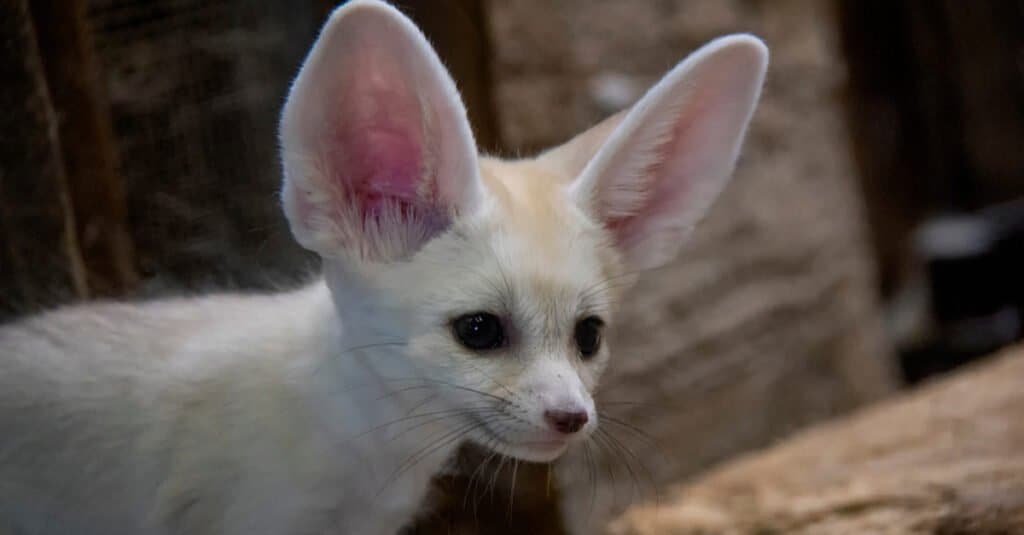
If miniature fennec foxes weren’t cute enough already, their too-big-for-their-head ears push them into fully adorable territory.
©Lucie Bartikova/Shutterstock.com
The fennec fox (Vulpes zerda) is known for its small size and shocking ears that measure up to 6 inches.
Native to the Sahara Desert in North Africa, fennec foxes are among the most miniature animals in the canid family. They measure around 14-16 inches long and weigh about two to three pounds. They are omnivores that primarily feed on insects, like termites, spiders, and grasshoppers. But they will also scavenge for small rodents, tiny mammals, eggs, and berries. They rely on roots and plants to hydrate themselves when water is scarce.
If miniature fennec foxes weren’t cute enough already, their too-big-for-their-head ears push them into fully adorable territory. Their huge ears add to their aesthetic appeal and indicate their ability to hear prey under sandy surfaces. They also offer the advantage of a flattened shape that helps dissipate heat more efficiently on hot days.
Fennec foxes have extremely sensitive hearing, which allows them to locate food quickly despite desert temperatures. Furthermore, they communicate with each other by making loud noises or thumping against the ground with their feet or tail. Their big ears are undoubtedly advantageous in picking up these communications.
Serval
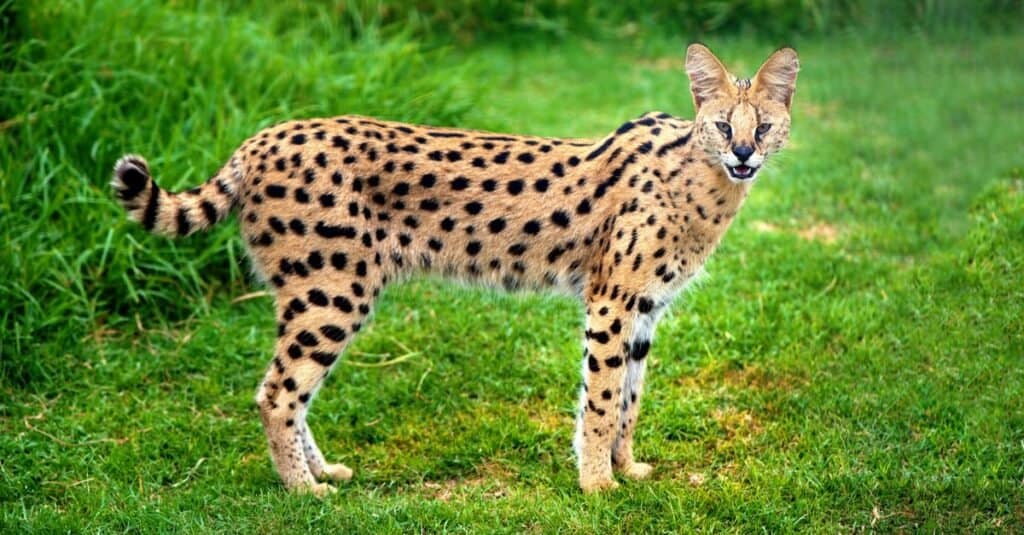
As adept hunters, servals use their long legs to leap 3 feet into the air and pounce on their targets!
©Howard Klaaste/Shutterstock.com
The serval (Leptailurus Serval) is a medium-sized wildcat that inhabits the savannas of Africa. Their large ears help amplify sound waves. This allows them to better detect smaller prey, like rodents and frogs that hide under rocks or burrow underground. This gives them an advantage over other cats when it comes to hunting in areas where food may be scarce.
As adept hunters, servals use their long legs to leap 3 feet into the air and pounce on their targets!
Although solitary by nature, servals form pair bonds during mating season and are highly territorial. While they might look cute, they have very sharp claws and teeth, making them unsuitable to be kept as pets.
Red Kangaroo
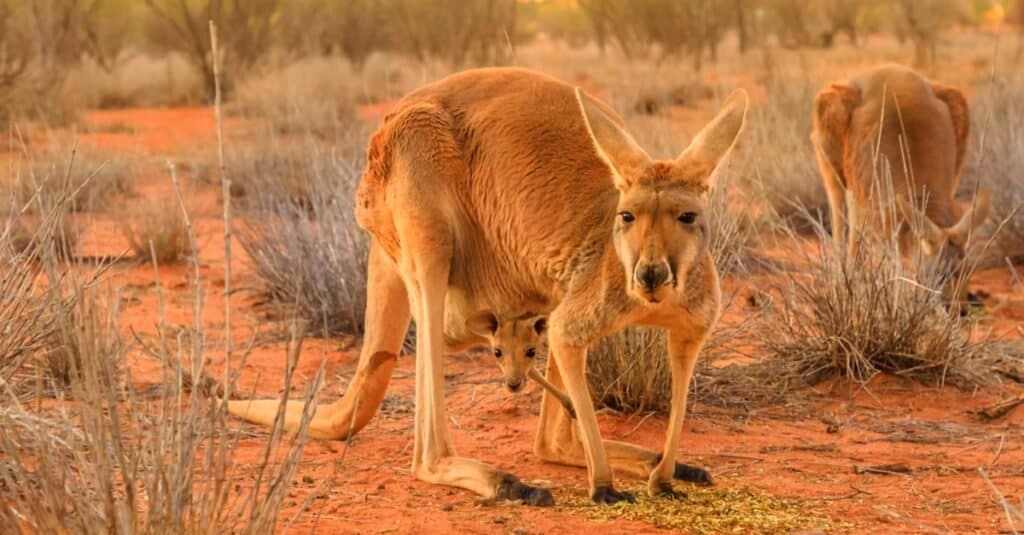
These large kangaroos use their remarkable ability to move their large, roundish ears independently, similar to a radar system.
©Benny Marty/Shutterstock.com
Red kangaroos, scientifically known as Osphranter Rufus, are among the most impressive animals due to their jumping capabilities. They are the largest species of kangaroo and can weigh anywhere between 88 to 200 lbs. They measure 4.9-5.9 feet in height. This species is native to Australia.
Red kangaroos use their remarkable ability to move their large, roundish ears independently, similar to a radar system. This helps them detect danger or other moving creatures in the distance, while grazing on numerous green grass fields. Their big ears also help them stay alert and detect approaching predators, so they can escape if needed.
Red Kangaroos are herbivores, with 75% of their diet comprising green grasses. These creatures are fascinating and love to show off by flexing their muscles when threatened or courting potential mates.
Aardvark

Aardvarks can consume up to 50,000 ants in a single night!
©Chris Bartnik / CC BY-ND 2.0, Flickr – License
As the largest insectivore on the African continent, the Aardvark (Orycteropus afer) is an impressive creature. Aardvarks mainly feed on insects such as ants and termites. They can consume up to 50,000 ants in a single night!
This shy animal weighs an average of 88-140 lbs and stands between 3.3-4.3 feet tall. They be found in the lower regions of Africa. Aardvarks are considered close relatives to elephants, fittingly enough, given their scientific name. This fascinating mammal is aptly named “Aardvark,” a term of Afrikaans origin. It means ‘earth pig’ and was given the name due to their physical resemblance to pigs and similar burrowing habits.
Aardvarks are nocturnal creatures that use their long, sticky tongues to capture prey. They possess remarkable hearing abilities that aid them in detecting prey underground. Their ears amplify sound waves, enabling them to detect even the slightest footfalls.
While Aardvarks can move about during the day and night, they typically prefer to come out only at night. Unfortunately, they have several natural predators, including lions, leopards, hyenas, and pythons. Despite this, their population appears to remain stable.
Aye-Aye
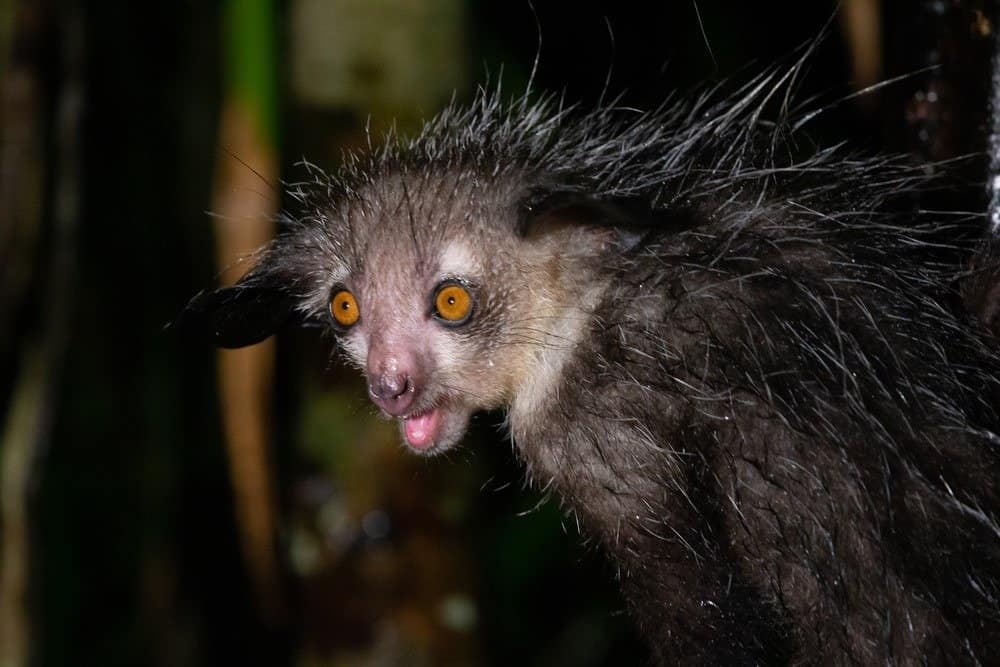
Aye-ayes are unique in that they possess both rodent-like incisors and primate-like canines.
©Eugen Haag/Shutterstock.com
The aye-aye (Daubentonia madagascariensis) is a lemur native to Madagascar and is one of the most peculiar animals. It is also the largest nocturnal primate in the world.
Aye-ayes are unique in that they possess both rodent-like incisors and primate-like canines. Additionally, they have skinny middle fingers that they use to tap on tree trunks to find insects underneath the bark. Once an insect is located, the aye-aye uses its long middle finger to extract it.
They are omnivorous and mainly feed on larvae and grubs as part of their unusual feeding pattern. However, they can also eat nectar, seeds, and fruits. Aye-ayes have large ears that amplify sound waves, allowing them to locate prey hidden from view.
These primates do not appear to be closely related to other primates. But they are, in fact, closely related to chimpanzees and apes. Aye-ayes weigh around 4 pounds and stand between 14-17 inches tall, which allows them to move quickly through the rainforest.
Unsurprisingly, given their powerful ears, these lemurs are rather timid creatures only found in Madagascar. Unfortunately, native people in Madagascar consider aye-ayes to be harbingers of evil due to their unique features.
Nevertheless, if you are fortunate enough to catch a glimpse of one of these marvelous night dwellers with their iconic ears, you will understand why they are so special.
Mule Deer

Despite their enormous size, they are incredibly agile athletes, capable of running as fast as 45 mph and jumping eight yards.
©iStock.com/twildlife
The mule deer, scientifically known as Odocoileus hemionus, is a deer species found in western North America. These creatures are named after their characteristic large ears that resemble those of a mule. Mule deer can weigh up to 331 pounds and reach heights of 6.9 feet.
Despite their enormous size, they are incredibly agile athletes, capable of running as fast as 45 mph and jumping eight yards. Mule deer use their large ears to help them stay cool in hot climates and to listen to predators. These big ears also amplify sounds, enabling them to hear approaching predators from far away. This is an invaluable advantage when it comes to staying safe in the wild.
Additionally, their excellent eyesight allows them to spot potential predators from over 2,000 ft away. Even more impressive is their incredible capacity for long-distance travel. The longest known migration pattern reaches up to 150 miles.
American Brahman
The American Brahman, scientifically known as Bos indicus/indicus, is a hybrid cattle breed originating from the Asian humped cattle breed.
One of the most distinctive features of the Brahman is its large shoulder hump, as well as its curved horns. However, the trait that stands out the most is their floppy, oversized ears. These ears enhance hearing and help the Brahman stay cool in hot weather by increasing surface area for heat loss.
Aside from their excellent physical characteristics, Brahman cattle are celebrated for their unique immune system and resistance to illness. The excess skin around their necks and shoulders not only gives them a unique appearance but also acts as a natural safeguard against heat and pesky bugs.
The Brahman is a popular breed for meat production. It is widely raised in countries such as Argentina, Brazil, the United States, and Australia.
Due to their longevity, some individuals can produce calves at age 15 or older. They live longer than any other cattle breed. It’s no wonder why the American Brahman is highly valued and loved in many countries worldwide.
The Caracal
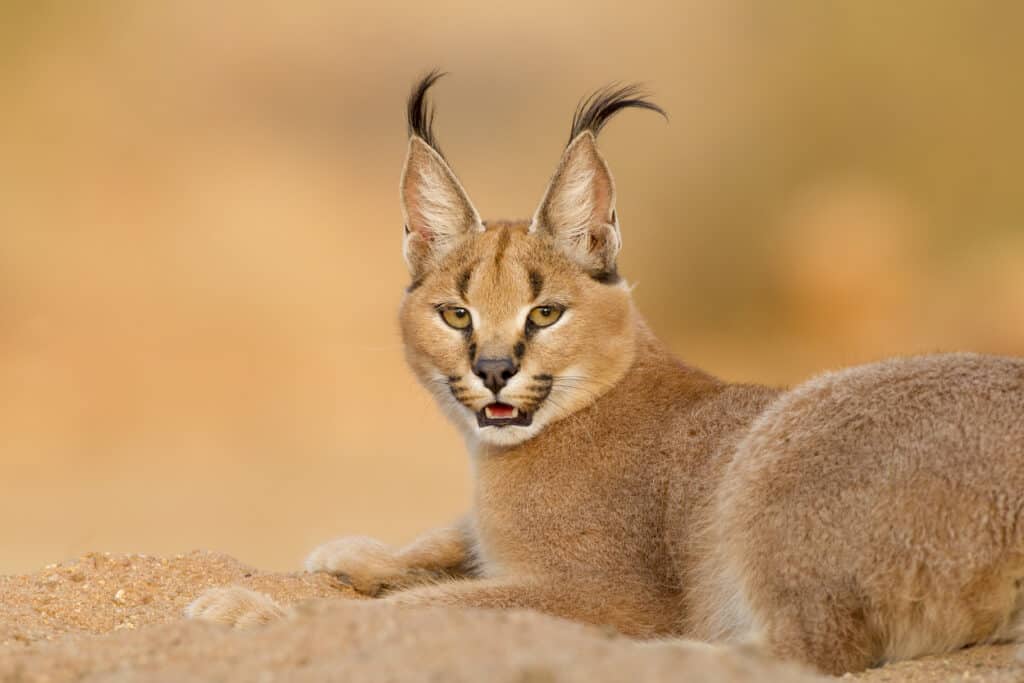
Black tufts on the tips of its ears act like radar dishes, which help locate prey even at night.
©iStock.com/StuPorts
The caracal, scientifically called Caracal caracal, is named for its ultra stylish ears. In Turkish, ‘Karrakh-kulak’ translates to “cat with big ears.” The caracal weighs between 25 and 45 pounds and stands 2 to 3.5 feet tall. This uniquely gorgeous feline is found in Asia and Africa’s forests, savannas, and deserts.
The caracal has over 20 muscles in each ear, and each ear can turn independently up to 180 degrees. Black tufts on the tips of its ears act like radar dishes, which help locate prey even at night. It’s an adept hunter capable of catching small mammals, birds, and rodents.
Its sound-hunting abilities allow it to locate prey from far distances. It uses its formidable jumping ability and excellent night vision to catch birds in mid-air up to 12 feet high! Caracals can even change direction mid-air if needed.
Scientists often find it challenging to observe these sly animals due to their nocturnal nature and secretive behavior. However, caracals are known to make sounds such as hissing, meowing, growling, and purring like other cats.
Galago
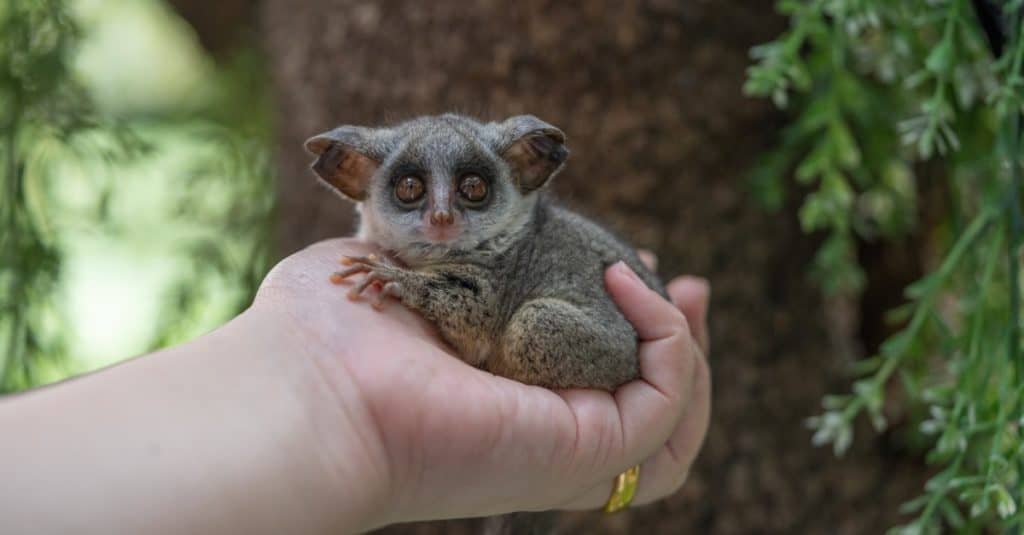
These fast and agile little critters can impressively jump up to 7 feet, keeping them out of harm’s way.
©akegooseberry/Shutterstock.com
Galago, scientifically known as Galagidae, is a fascinating teeny tiny creature. They are commonly known as bush babies or nagapies in Afrikaans, meaning “night monkeys.” These creatures reside in the forests of the Sub-Saharan region in Africa. They are marked by their round eyes and bat-like ears, which rotate toward sound to pick up prey.
These fast and agile little critters can impressively jump up to 7 feet, keeping them out of harm’s way. They mostly live in trees and feed by snatching insects out of the air. Their hearing assists them immensely in this task.
Furthermore, they mark their territory through a process called “urine wiping.” During this ritual, they dab small amounts of urine on branches as scent signals.
The European Hare
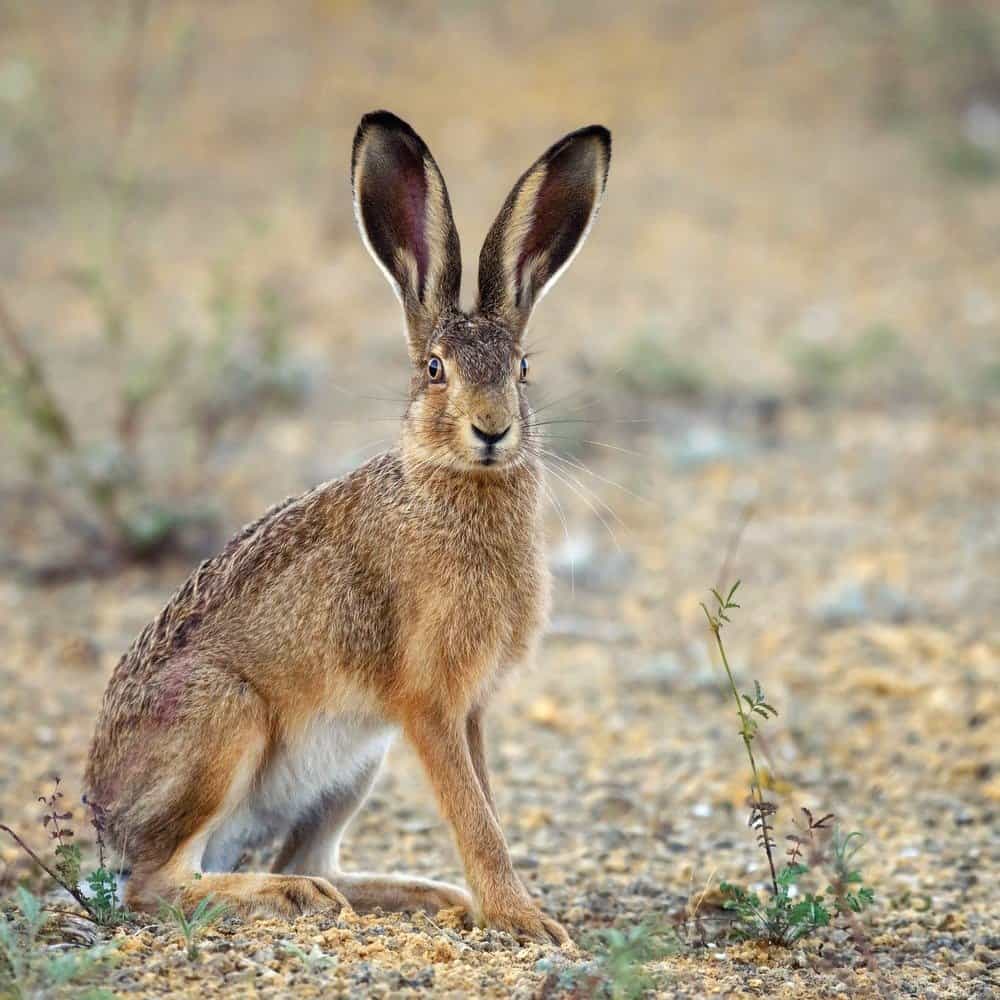
When threatened or cornered, this species displays boxer-style defense tactics.
©WildlifeWorld/Shutterstock.com
The European hare, or brown hare (Lepus Europaeus), is a prominent and widespread species in Asia and Europe. It is one of the largest hare species due to its physical features, including long legs and tall, black-tipped ears. These hares measure up to 4.3 inches in length.
When threatened or cornered, this species displays boxer-style defense tactics. These often involve jumping into the air while slapping their opponents with their massive feet. European hares feed predominantly on herbs and grasses but also supplement their diet with barks, buds, and twigs.
Although the European hare has its share of predators, it evades them with its super-speed abilities. They reach top speeds of 45 mph over short distances. Foraging for food makes up about 1/3 of this hare’s life. They spend a great deal of time gathering plants for sustenance and nourishment.
Evolutionary and Natural Environment Advantages for Animals with Big Ears
Studies have shown that large ears play an essential role for animals living in far-off lands. Bigger ears provide them with a larger surface area from which to pick up sound waves. They can detect sound from much further away than their smaller-eared counterparts.
Animals with super-sized ears use the extra sensitivity to sense the presence of predators or prey from greater distances. The result for these creatures is greatly enhanced survival skills. This explains why such characteristic traits evolved throughout generations in the animal kingdom.
The photo featured at the top of this post is © iStock.com/Anolis01
Thank you for reading! Have some feedback for us? Contact the AZ Animals editorial team.






